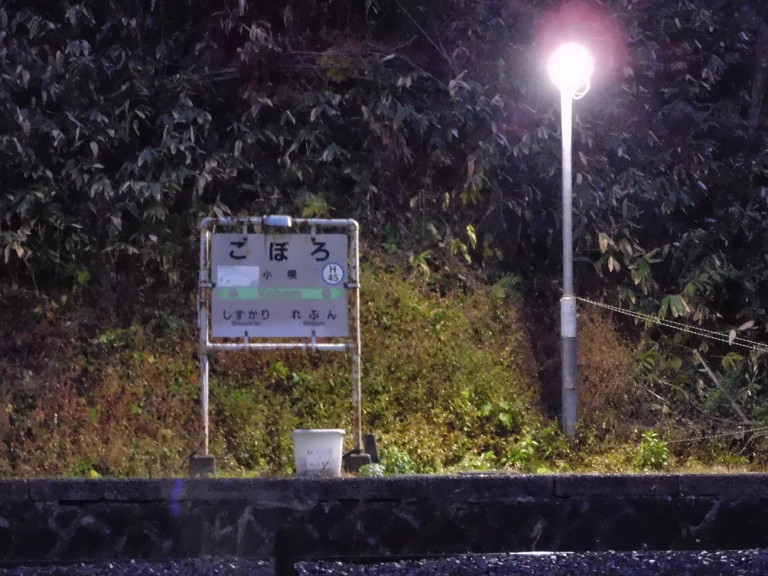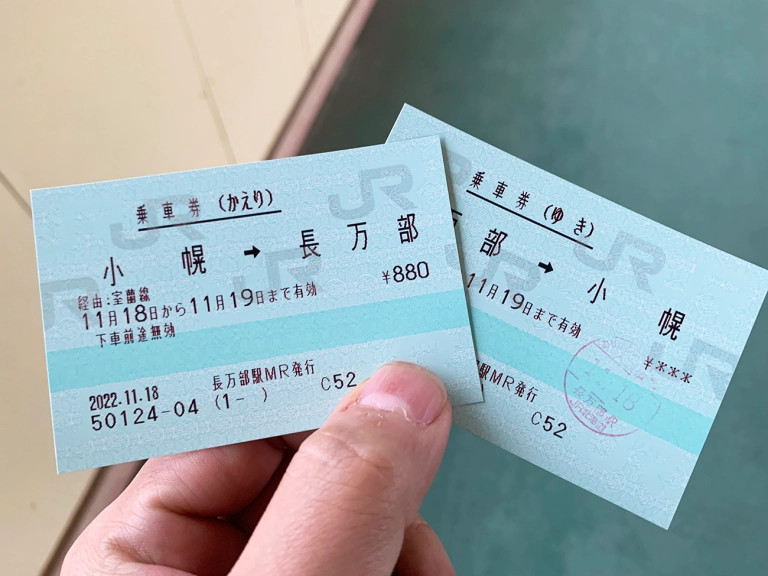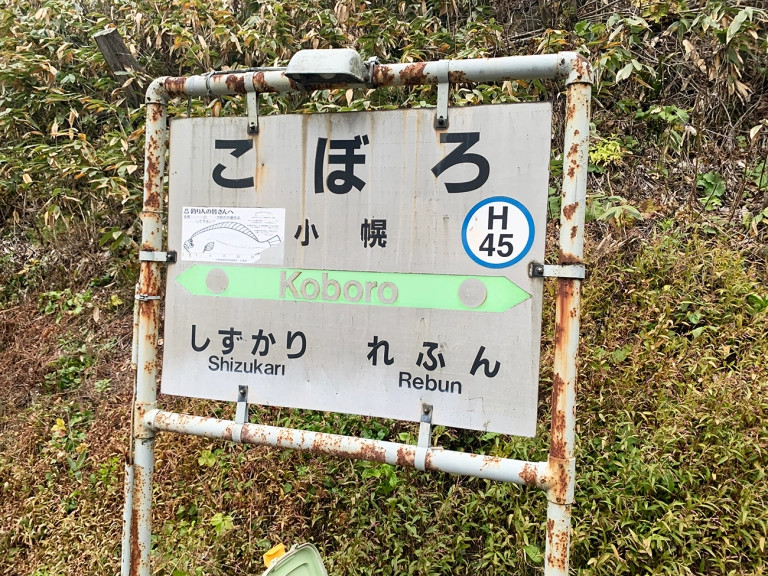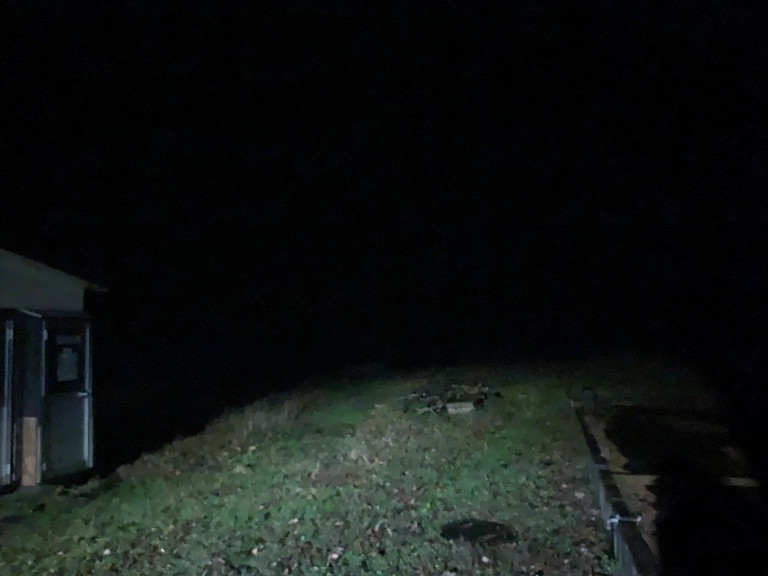
A mystical, hidden place only serviced by two trains per day: secret gem, or portal to another world?
If you’ve been on a countryside train in Japan, you’ve probably seen tiny wayside stations made more of trees than cement, with barren platforms that a lot of trains except the most local zip right through. Or maybe not; if you blink, you’d probably miss them.
Our Japanese-language reporter Seiji Nakazawa spotted one while traveling to the city of Oshamambe on the Hokuto, a limited-express train that runs between Sapporo and Otaru in the northern prefecture of Hokkaido. As he was gazing out the window, watching the scenery go by, he caught a glimpse of a strange station that flashed past him.
It wasn’t just that it was a small, empty station that gave Seiji a sense of discomfort. It was that the station lay between two tunnels in a mountainous district. While looking out the window, Seiji was surprised when they blasted out of a tunnel, through a station, and then back into another tunnel. The only thing Seiji had time to see was a beat-up signboard, which almost had him doubting what he’d seen.
When he arrived at Oshamambe and investigated, he learned that there is a fairly famous secluded station on the JR Muroran Line called Koboro Station.
But as Seiji observed, the station is surrounded by mountains, with a cliff face to its back and an ocean to its front, so the place was inaccessible by car or on foot. Which means the only way to go…
…was by a local train that only departs from Oshamambe twice a day. While there are actually four trains that leave from Oshamambe Station and head towards Gohoro, the 5:44 a.m. and 6:38 a.m. trains don’t stop there and only pass through it. The only trains that stop at Koboro leave at 3:34 p.m. and 7:28 p.m.
Taking the 7:28 p.m. train meant arriving at night, which wouldn’t be great for taking photos, so Seiji had no choice but to take the 3:34 p.m. train.
▼ The fare, by the way, was 880 yen (US$6.44) one-way.
Seiji arrived at 3:50 p.m.. The fact that it was only three stations away from Oshamambe Station was the place’s only saving grace, considering how late Seiji had arrived. In the middle of the mountains, 3:50 p.m. was just about approaching dusk.
Seiji was surprised to see five people get on the train he’d just gotten off at Koboro. After briefly wondering how they got there before him, he guessed that trains that come from the opposite direction probably leave earlier, so it might be easier to travel to Koboro from Muroran.
After he got his bearings, Seiji glanced around to see that the station really was sandwiched between two tunnel entrances, like a puzzle piece slotted into the perfect place. The platform was very narrow and felt more like a passing lane than an actual platform.
With the simple construction, the two tunnel entrances on either side, and the fact that one side of the station was backed up against a steep mountain face, Seiji felt rather trapped, like the two tunnels and the mountain were the sides of a box.
The open side of the box was on the same side as the platform for Oshamambe, a little opening between trees where there was a toilet and…some kind of station building?
That was about it when it came to the actual station. Seiji didn’t think it was especially scenic or pretty but he did find a plastic case on the platform for Muroran which contained 12 station guestbooks. There was also a doujinshi, or fan manga, in there. After traveling to Koboro and seeing how difficult it was to get there for himself, Seiji really felt the love borne by the train otaku who came all that way to leave their messages in the guest books.
The next train returning to Oshamambe was at 5:34, so Seiji had about an hour and a half to explore. He took a look around the area…
And found two arrow signs pointing in opposite directions, one for “Iwaya Kannon”, a temple, and one for “Buntaro Beach.” Perhaps these were places with nice views? Seiji supposed he probably only had time to see one, so he headed for Iwaya Kannon.
He ended up going on a serious mountain hike along a tiny path only wide enough for one person, with a sheer cliff drop on one side. Seiji would occasionally get a glimpse of the ocean that lay distant down at the bottom of the cliff, which made his legs shake. If he made a single misstep, he would fall to his death. It was truly terrifying.
Having had his fill of treacherous, remote mountain paths leading to hidden sightseeing spots, he was relieved when he finally made it to Iwaya Kannon. It was near a little sandy beach sandwiched between a barren mountain face and a cliff wall.
In the mountain face was a little cave where the Iwaya Kannon statues were. Apparently, they were carved and hidden here by the Buddhist monk Enku in 1666.
1666 would put Japan right at the beginning of the Edo period, the age of the shogun. That was long before the development of Hokkaido, so the fact that someone came here, to the remotest of backcountries, in 17th century Japan and placed Kannon statues in a cave is impressive in a “glad it wasn’t me” kind of way.
Honestly, the sheer fact that someone managed to come here during the Edo period is impressive. Just getting here in the age of modern transportation is difficult enough–imagine walking to a place like this!
Along those lines, Seiji began to wonder, why build a station in a place like this anyway? He couldn’t stop thinking about it, so he asked at the Toyoura Town Hall, which manages Koboro Station.
Toyoura Town Hall: “Koboro Station was apparently once a signal station.”
Seiji: “What’s a “signal station”?”
Toyoura Town Hall: “A place built to facilitate train traffic. At the time, steam trains, which belched smoke, couldn’t stop in tunnels, so this was a safe place for them to stop while another was coming through. Repair laborers used to use it too. According to documents found, the signal station was built in 1943, but because some fishermen lived nearby, they elevated it to a station.”
Seiji thought that was very interesting information. He did see the remains of a bridge near the Iwaya Kannon, which may have been used by the fishermen at the time.
Still, he couldn’t get over how extremely remote the place was. By the time Seiji returned to the station from Iwaya Kannon, the sun had completely sunk behind the mountain, and Gohoro Station had become a dim pinprick of light in the darkness. The “Koboro” sign under the light of the single lamppost made the place seem even more mystical.
By the way, it goes without saying that there was pretty much no phone service anywhere around there. Seiji could sometimes get one bar, but it was in and out. He could hardly get Softbank’s automatic home page to load, never mind any apps like Twitter. The wait for the train was long and boring.
Soon it began to drizzle, and Seiji thought he heard the sounds of festival music and drums coming from nearby. He glanced at his watch–he had some time. “Maybe I’ll just go have a look…” he thought.
And we never saw him again.
Just kidding! He wrote this from his desk at the office. Didn’t he? Hey…has anyone seen Seiji?
Images © SoraNews24
● Want to hear about SoraNews24’s latest articles as soon as they’re published? Follow us on Facebook and Twitter!
[ Read in Japanese ]























 The oldest tunnel in Japan is believed to be haunted, and strange things happen when we go there
The oldest tunnel in Japan is believed to be haunted, and strange things happen when we go there We deeply regret going into this tunnel on our walk in the mountains of Japan
We deeply regret going into this tunnel on our walk in the mountains of Japan What does a family restaurant in the middle of nowhere, Hokkaido, serve? We find out
What does a family restaurant in the middle of nowhere, Hokkaido, serve? We find out Pokémon lid becomes Japan’s most overprotected manhole cover, melts hearts across the country
Pokémon lid becomes Japan’s most overprotected manhole cover, melts hearts across the country Hayao Miyazaki says Happy New Year to Studio Ghibli fans with new art for Year of the Horse
Hayao Miyazaki says Happy New Year to Studio Ghibli fans with new art for Year of the Horse The best Starbucks Japan Frappuccinos we want to drink again in 2026
The best Starbucks Japan Frappuccinos we want to drink again in 2026 We revisited Sweets Paradise after a decade to see if Japan’s dessert buffet still delivers
We revisited Sweets Paradise after a decade to see if Japan’s dessert buffet still delivers Starbucks Japan unveils new S’mores Frappuccino and latte for Christmas 2025
Starbucks Japan unveils new S’mores Frappuccino and latte for Christmas 2025 Japan’s otoshidama tradition of giving kids money at New Year’s gets a social welfare upgrade
Japan’s otoshidama tradition of giving kids money at New Year’s gets a social welfare upgrade Shogun arrested in Japan for being a peeping Tom
Shogun arrested in Japan for being a peeping Tom Studio Ghibli releases Kodama forest spirits from Princess Mononoke to light up your home
Studio Ghibli releases Kodama forest spirits from Princess Mononoke to light up your home Japan’s oldest largetooth sawfish in captivity back on display in Mie Prefecture
Japan’s oldest largetooth sawfish in captivity back on display in Mie Prefecture More people in Japan quit sending New Year’s cards and many have started to regret it
More people in Japan quit sending New Year’s cards and many have started to regret it These are Osaka’s three best digital rail passes for travelers
These are Osaka’s three best digital rail passes for travelers Starbucks Japan ready to get Year of the Horse started with adorable drinkware and plushies【Pics】
Starbucks Japan ready to get Year of the Horse started with adorable drinkware and plushies【Pics】 Cyberpunk anime meets traditional culture in Ghost in the Shell gold leaf Japanese changing screens
Cyberpunk anime meets traditional culture in Ghost in the Shell gold leaf Japanese changing screens 7 great places to see Mt. Fuji from without having to climb it
7 great places to see Mt. Fuji from without having to climb it Hello Kitty Choco Egg figures are an adorable trip through three periods of Japanese pop culture【Pics】
Hello Kitty Choco Egg figures are an adorable trip through three periods of Japanese pop culture【Pics】 7-Eleven Japan’s ramen-cooking robot whipped us up a bowl of noodles【Taste test】
7-Eleven Japan’s ramen-cooking robot whipped us up a bowl of noodles【Taste test】 We found possibly the quietest Japanese-style hotel in Tokyo’s bustling Shinjuku district
We found possibly the quietest Japanese-style hotel in Tokyo’s bustling Shinjuku district Sumo Sanrio! Hello Kitty and pals team up with Japan Sumo Association for new merch【Pics】
Sumo Sanrio! Hello Kitty and pals team up with Japan Sumo Association for new merch【Pics】 More Than a Capsule Stay: Why Solo Travelers Choose “global cabin Yokohama Chinatown”
More Than a Capsule Stay: Why Solo Travelers Choose “global cabin Yokohama Chinatown” 7-Eleven Japan starts new temporary luggage storage service in over 300 branches
7-Eleven Japan starts new temporary luggage storage service in over 300 branches Disillusionment at Tsukiji’s tourist-target prices led us to a great ramen restaurant in Tokyo
Disillusionment at Tsukiji’s tourist-target prices led us to a great ramen restaurant in Tokyo Starbucks teams up with 166-year-old Kyoto doll maker for Year of the Horse decorations【Photos】
Starbucks teams up with 166-year-old Kyoto doll maker for Year of the Horse decorations【Photos】 Tokyo considering law requiring more trash cans following litter increase in heavily touristed area
Tokyo considering law requiring more trash cans following litter increase in heavily touristed area Tokyo’s Tsukiji sushi neighborhood asks tour groups to stay away for the rest of the month
Tokyo’s Tsukiji sushi neighborhood asks tour groups to stay away for the rest of the month Tokyo event lets you travel back in time, for free, to celebrate 100 years since Showa era start
Tokyo event lets you travel back in time, for free, to celebrate 100 years since Showa era start Sanrio theme park in Japan announces plans to expand into a Sanrio resort
Sanrio theme park in Japan announces plans to expand into a Sanrio resort Japan may add Japanese language proficiency, lifestyle classes to permanent foreign resident requirements
Japan may add Japanese language proficiency, lifestyle classes to permanent foreign resident requirements Stamina-destroying “Paralysis Noodles” are Tokyo’s newest over-the-top ramen innovation
Stamina-destroying “Paralysis Noodles” are Tokyo’s newest over-the-top ramen innovation Survey asks foreign tourists what bothered them in Japan, more than half gave same answer
Survey asks foreign tourists what bothered them in Japan, more than half gave same answer Japan’s human washing machines will go on sale to general public, demos to be held in Tokyo
Japan’s human washing machines will go on sale to general public, demos to be held in Tokyo Japan’s deadliest food claims more victims, but why do people keep eating it for New Year’s?
Japan’s deadliest food claims more victims, but why do people keep eating it for New Year’s? We deeply regret going into this tunnel on our walk in the mountains of Japan
We deeply regret going into this tunnel on our walk in the mountains of Japan Major Japanese hotel chain says reservations via overseas booking sites may not be valid
Major Japanese hotel chain says reservations via overseas booking sites may not be valid Put sesame oil in your coffee? Japanese maker says it’s the best way to start your day【Taste test】
Put sesame oil in your coffee? Japanese maker says it’s the best way to start your day【Taste test】 No more using real katana for tourism activities, Japan’s National Police Agency says
No more using real katana for tourism activities, Japan’s National Police Agency says Starbucks Japan reveals new sakura drinkware collection, inspired by evening cherry blossoms
Starbucks Japan reveals new sakura drinkware collection, inspired by evening cherry blossoms Updated cherry blossom forecast shows extra-long sakura season for Japan this year
Updated cherry blossom forecast shows extra-long sakura season for Japan this year
Leave a Reply